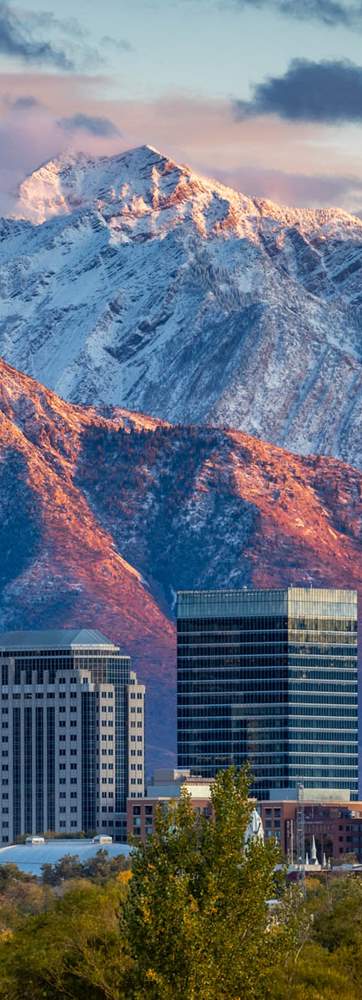
Wasatch Mountains
Wasatch Front
Salt Lake Valley
For many, it’s the u-shaped canyons that define the Wasatch Mountains. In all, seven canyons feed into the Salt Lake Valley from the range to the east. The glacier-carved Little Cottonwood is a 15-mile-long adventureland strewn with lovely quartz monzonite for climbing, blanketed with national forest for exploring, and carefully developed with stunning slopes for skiing and riding (Snowbird Ski and Summer Resort and Alta Ski Area call Little Cottonwood Canyon home). There’s also mountain biking, cycling, climbing and all kinds of wildlife wandering among the summer wildflowers (like at Albion Basin) and winter wonderlands.
The 15-mile-long canyon just north of Little Cottonwood is Big Cottonwood. Like its neighbor to the south, two major ski resorts anchor the canyon’s list of outdoor recreation — Solitude Mountain Resort and Brighton Ski Resort — and like Little Cottonwood, snow levels are deep in the winter and the powder can be endless. Big Cottonwood offers a solid mix of bolted and traditional climbs, a beautiful scenic drive or ride and some of the best trails, including the popular hike to Lake Blanche in the Twin Peaks Wilderness Area and access to the Wasatch Crest hiking and biking system, that connects with trails in the Park City area and the popular Millcreek Canyon.
See other top Utah hikes near Salt Lake City.
Utah Valley
Several canyons rise out of the Utah Valley as well, including the stunning Alpine Loop through American Fork Canyon (home to Timpanogos Cave National Monument and Sundance Mountain Resort), Provo Canyon and Spanish Fork Canyon.
The Provo River cleaves the range in Provo backyard, forming Provo Canyon, and serving as the setting for scenic fly-fishing, kayaking and floating. The surrounding mountains cradle an extensive network of trails for hiking, biking, horseback riding and mountaineering. Both River Ranch Adventures and Sundance Mountain Resort host zip lining.
North of Salt Lake
Heading north from Salt Lake City, several canyons offer sanctuary to the suburbs of Davis County (like Bountiful’s Mueller Park) and the metropolitan Ogden-Clearfield area, including the stunning Ogden River Scenic Byway (S.R. 39) that access the Ogden Valley’s three ski resorts (Snowbasin Resort, Nordic Valley Ski and Outdoor Recreation and Powder Mountain Resort) and the popular Pineview Reservoir (review how to visit responsibly).
Wasatch Back
Park City
Park City, Utah, could certainly stake a rightful claim of being the “perfect mountain town.” Combining its silver mining town heritage, a progressive vibe and a deep appreciation for the outdoors, Park City strikes a balance between luxury and comfort, all the while showing a deep appreciation for athletics, the arts and fine dining. Park City is home to the largest ski resort in the United States (Park City/Canyons) as well as the acclaimed Deer Valley and is the world's only IMBA-certified Gold Level riding destination.
Heber
The Heber Valley astonishes with its alpine splendor and access to endless outdoor recreation only 20 miles from Park City, or 45 minutes from Salt Lake City. Exclusive resorts, authentic dining and world-class golf round out the valley's extensive list of incredible accommodations and vast trail network, which means your Heber Valley sanctuary can be built on luxury (European-style hotels like Zermatt Resort and Spa and Blue Boar Inn Bed and Breakfast), off the road (Wasatch Mountain State Park), or a combination of both.
-

Hiking Near Salt Lake City
Lush and beautiful mountains and canyons (which include four world-class ski resorts for winter visitors) sit on the borders of Salt Lake City and offer hiking opportunities within minutes of its hustle and bustle.
-

Mountain Biking
Explore Utah mountain biking on the state’s most popular trails including Slickrock, Gooseberry Mesa, Thunder Mountain and Good Water Rim.


